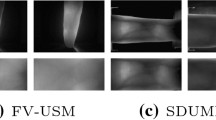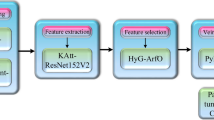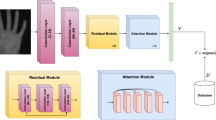Abstract
Finger vein recognition technology has been widely used in various identity authentication scenarios due to its convenience, fast recognition speed, and high security. However, there is an inevitable problem that seriously affects its recognition, which is the change of finger poses, such as shift and rotation during the image acquisition process. Therefore, how to extract finger vein features that are more robust to finger pose changes is a more concerned issue. We analyze the multi-pose finger vein images in practical application scenarios, and find the fact that the global vein features of the same finger are quite different while the local features are highly similar. In most existing finger vein recognition algorithms based on convolutional neural network (CNN), only global finger vein features are extracted by global average pooling (GAP), which fails to take full account of the above fact. In this paper, we proposed a finger vein feature extraction network fusing global and local features (FGL-Net) and its lightweight network KD-FGL-MobileNet, which effectively improves finger vein recognition performance in different finger poses. Firstly, FGL-Net consists of two parts, the backbone network based on the designed ResBlock with Mish is used to extract the high-level semantic features of finger veins, and then the global and local feature extraction module with three independent branches are designed to fully learn the global and local finger vein features at different granularities, and finally all the features of the three branches are fused into a fusion feature with greater robustness to pose change for recognition. To improve the generalization ability of the network, the CurricularFace loss is added to train FGL-Net with the cross-entropy loss. Such design not only aggregates homologous features and separates heterologous features, but also mines finger vein image samples under special poses online for intensive training. Secondly, according to the characteristics of the finger veins, we design a lightweight residual block based on fast receptive field (SE-FrfResBlock) to build a more lightweight FGL-MobileNet. A knowledge distillation loss and a feature map loss are added to FGL-MobileNet to address the generalization performance degradation of FGL-MobileNet, and we named it KD-FGL-MobileNet. On FV-USM, FV-Normal and FV-Specical datasets, compared with VGG-Net and InceptionResnet, the Top1 ranking of FGL-Net are improved by 2.38%, 8.26%, 13.42% and 0.00%, 1.17%, 9.95%, and the recognition rate are improved by 9.42%, 18.59%, 28.33% and 0.72%, 7.12%, 20.88%. On FV-Specical datasets, compared with MobileNetv3, FGL-MobileNet, the recognition rate and Top1 ranking of KD-FGL-MobileNet are improved by 24.12% ,6.19% and 12.46%, 3.78%. The above results show that the proposed FGL-Net effectively improves the recognition performance of finger vein images in different poses, and KD-FGL-MobileNe requires less storage space while remaining basically consistent with the performance of FGL-Net.










Similar content being viewed by others
Explore related subjects
Discover the latest articles and news from researchers in related subjects, suggested using machine learning.Data availability
The datasets of this paper consists of three parts: FV-USM dataset that support the findings of this study is available in [Finger Vein USM Database] with the identifier http://dx.doi.org/10.1016/j.eswa.2013.11.033] Asaari et al. (2014), FV-Normal and FV-Special datasets are not available due to trade secrets. No known interest that can influence the work reported in this paper.
References
Abualigah L, Diabat A, Mirjalili S, Abd Elaziz M, Gandomi AH (2021) The arithmetic optimization algorithm. Comput Methods Appl Mech Eng 376:113609
Abualigah L, Diabat A, Sumari P, Gandomi AH (2021) Applications, deployments, and integration of internet of drones (IoD): a review. IEEE Sens J 21(22):25532–25546
Abualigah L, Yousri D, Abd Elaziz M, Ewees AA, Al-Qaness MA, Gandomi AH (2021) Aquila optimizer: a novel meta-heuristic optimization algorithm. Comput Ind Eng 157:107250
Abualigah L, Abd Elaziz M, Sumari P, Geem ZW, Gandomi AH (2022) Reptile search algorithm (RSA): a nature-inspired meta-heuristic optimizer. Expert Syst Appl 191:116158
Agushaka JO, Ezugwu AE, Abualigah L (2022) Dwarf mongoose optimization algorithm. Comput Methods Appl Mech Eng 391:114570
Asaari MSM, Suandi SA, Rosdi BA (2014) Fusion of band limited phase only correlation and width centroid contour distance for finger based biometrics. Expert Syst Appl 41(7):3367–3382
Clevert D-A, Unterthiner T, Hochreiter S (2015) Fast and accurate deep network learning by exponential linear units (ELUS). arXiv:1511.07289 (arXiv preprint)
Glorot X, Bordes A, Bengio Y (2011) Deep sparse rectifier neural networks. In: Proceedings of the fourteenth international conference on artificial intelligence and statistics. JMLR Workshop and Conference Proceedings, pp 315–323
Hinton G, Vinyals O, Dean J (2015) Distilling the knowledge in a neural network. Comput Sci 14(7):38–39
Hong HG, Lee MB, Park KR (2017) Convolutional neural network-based finger-vein recognition using NIR image sensors. Sensors 17(6):1297
Howard A, Sandler M, Chu G, Chen L-C, Chen B, Tan M, Wang W, Zhu Y, Pang R, Vasudevan V, et al. (2019) Searching for mobilenetv3. In: Proceedings of the IEEE/CVF international conference on computer vision, pp 1314–1324
Huang Y, Wang Y, Tai Y, Liu X, Shen P, Li S, Li J, Huang F (2020) Curricularface: adaptive curriculum learning loss for deep face recognition. In: Proceedings of the IEEE/CVF conference on computer vision and pattern recognition, pp 5901–5910
Hu J, Shen L, Sun G (2018) Squeeze-and-excitation networks. In: Proceedings of the IEEE conference on computer vision and pattern recognition, pp 7132–7141
Ismail B, Zmirli MO (2018) Enhancement of finger vein patterns extracted by maximum curvature method. In: 2018 international conference on applied smart systems (ICASS), pp 1–4. IEEE
Itqan K, Syafeeza A, Gong F, Mustafa N, Wong Y, Ibrahim M (2016) User identification system based on finger-vein patterns using convolutional neural network. ARPN J Eng Appl Sci 11(5):3316–3319
Kang BJ, Park KR (2010) Multimodal biometric method based on vein and geometry of a single finger. IET Comput Vis 4(3):209–217
Khellat-Kihel S, Cardoso N, Monteiro J, Benyettou M, et al. (2014) Finger vein recognition using gabor filter and support vector machine. In: International image processing, applications and systems conference, pp 1–6. IEEE
Li J, Ma H, Lv Y, Zhao D, Liu Y (2019) Finger vein feature extraction based on improved maximum curvature description. In: 2019 Chinese control conference (CCC), pp 7566–7571. IEEE
Liu T, Xie J, Yan W, Li P, Lu H (2013) An algorithm for finger-vein segmentation based on modified repeated line tracking. Imaging Sci J 61(6):491–502
Liu F, Yang G, Yin Y, Wang S (2014) Singular value decomposition based minutiae matching method for finger vein recognition. Neurocomputing 145:75–89
Liu W, Li W, Sun L, Zhang L, Chen P (2017) Finger vein recognition based on deep learning. In: 2017 12th IEEE conference on industrial electronics and applications (ICIEA), pp 205–210. IEEE
Lu Y, Yoon S, Xie SJ, Yang J, Wang Z, Park DS (2014) Finger vein recognition using generalized local line binary pattern. KSII Trans Internet Inf Syst 8(5):1766–1784
Lu Y, Xie SJ, Yoon S, Park DS (2013) Finger vein identification using polydirectional local line binary pattern. In: 2013 international conference on ICT convergence (ICTC), pp 61–65. IEEE
Maas AL, Hannun AY, Ng AY, et al. (2013) Rectifier nonlinearities improve neural network acoustic models. In: Proceedings of ICML, vol 30, p 3. Citeseer
Mantrao N, Sukhpreet K (2015) An efficient minutiae matching method for finger vein recognition. Int J Adv Res Comput Sci Softw Eng 5:657–660
Meng X, Zheng J, Xi X, Zhang Q, Yin Y (2021) Finger vein recognition based on zone-based minutia matching. Neurocomputing 423:110–123
Mish MD (2019) A self regularized non-monotonic activation function 2019. arXiv:1908.08681 (arXiv preprint)
Miura N, Nagasaka A, Miyatake T (2004) Feature extraction of finger-vein patterns based on repeated line tracking and its application to personal identification. Mach Vis Appl 15(4):194–203
Miura N, Nagasaka A, Miyatake T (2007) Extraction of finger-vein patterns using maximum curvature points in image profiles. IEICE Trans Inf Syst 90(8):1185–1194
Oyelade ON, Ezugwu AE-S, Mohamed TI, Abualigah L (2022) Ebola optimization search algorithm: a new nature-inspired metaheuristic optimization algorithm. IEEE Access 10:16150–16177
Prabhakar P, Thomas T (2013) Finger vein identification based on minutiae feature extraction with spurious minutiae removal. In: 2013 third international conference on advances in computing and communications, pp 196–199
Radzi SA, Hani MK, Bakhteri R (2016) Finger-vein biometric identification using convolutional neural network. Turk J Electr Eng Comput Sci 24(3):1863–1878
Rosdi BA, Shing CW, Suandi SA (2011) Finger vein recognition using local line binary pattern. Sensors 11(12):11357–11371
Song W, Kim T, Kim HC, Choi JH, Kong H-J, Lee S-R (2011) A finger-vein verification system using mean curvature. Pattern Recogn Lett 32(11):1541–1547
Syarif MA, Ong TS, Teoh AB, Tee C (2017) Enhanced maximum curvature descriptors for finger vein verification. Multimed Tools Appl 76(5):6859–6887
Szegedy C, Ioffe S, Vanhoucke V, Alemi AA (2017) Inception-v4, inception-resnet and the impact of residual connections on learning. In: Thirty-first AAAI conference on artificial intelligence
Wang X, Wang H, He Y, Ding Y, Tao L (2019b) Novel algorithm for finger vein recognition based on inception-resnet module. In: Eleventh international conference on digital image processing (ICDIP 2019), vol 11179, p 111791D. International Society for Optics and Photonics
Wu J, He D (2018) Finger vein recognition based on feature point distance. In: 2018 IEEE 3rd international conference on image, vision and computing (ICIVC), pp 163–167. IEEE
Yang J, Yang J (2009) Multi-channel gabor filter design for finger-vein image enhancement. In: 2009 fifth international conference on image and graphics, pp 87–91. IEEE
Yang J, Yang J, Shi Y (2009) Combination of gabor wavelets and circular gabor filter for finger-vein extraction. In: International conference on intelligent computing, pp 346–354. Springer
Zhang Y, Li W, Zhang L, Lu Y (2019) Adaptive gabor convolutional neural networks for finger-vein recognition. In: 2019 international conference on high performance big data and intelligent systems (HPBD &IS), pp 219–222. IEEE
Author information
Authors and Affiliations
Corresponding author
Additional information
Publisher's Note
Springer Nature remains neutral with regard to jurisdictional claims in published maps and institutional affiliations.
Rights and permissions
Springer Nature or its licensor (e.g. a society or other partner) holds exclusive rights to this article under a publishing agreement with the author(s) or other rightsholder(s); author self-archiving of the accepted manuscript version of this article is solely governed by the terms of such publishing agreement and applicable law.
About this article
Cite this article
Xu, W., Shen, L., Wang, H. et al. A finger vein feature extraction network fusing global/local features and its lightweight network. Evolving Systems 14, 873–889 (2023). https://doi.org/10.1007/s12530-022-09475-9
Received:
Accepted:
Published:
Issue Date:
DOI: https://doi.org/10.1007/s12530-022-09475-9




